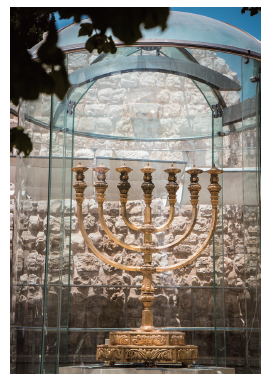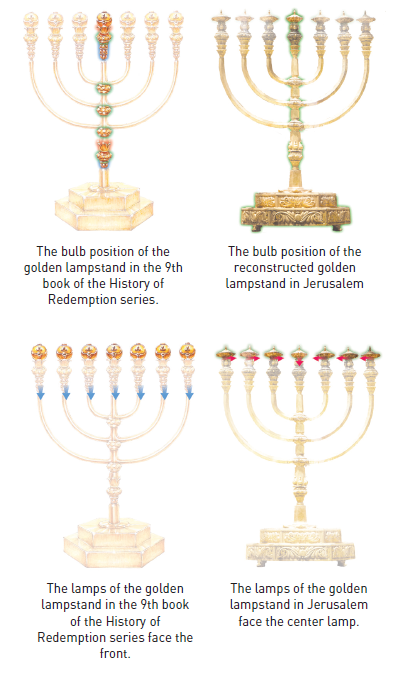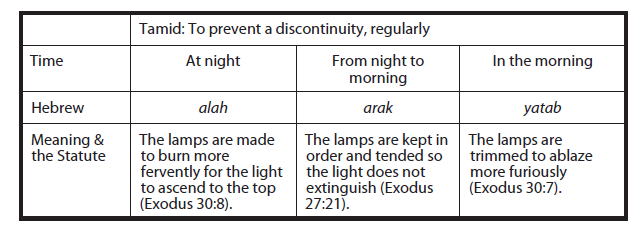
Every nation has a building or
sculpture that represents that nation: the Statue of Liberty in America, the
Eiffel Tower in France, and the Coliseum in Italy, etc. If the Jewish people
were asked to speak on what represents Israel, they would immediately choose
the golden lampstand (Hebrew-language: Manorah). If foreigners were asked on
what comes to their mind when they hear, “Israel,” many would choose the
Wailing Wall. Ironically, the golden lampstand and the Wailing Wall, which are
symbolic icons of Israel, are located very close to each other, a walking
distance of 5 minutes away.

The golden lampstand

Among
the many holy objects that appear in the Bible, the golden lampstand was
probably the most difficult to make. The challenges were not limited to adjusting
the balance or symmetry of the golden lampstand or to performing such
meticulous craftsmanship: the structure could not be made by assembling small
parts. One talent of pure gold (which would be worth about 4.5 billion won
today) is flattened to a circular shape with a hammer, and then meticulously carved
with a sharp tool into a single, intact object. This work probably required the
best craftsmanship of the time. God called Bezalel, the son of Uri, the son of
Hur, of the tribe of Judah for this special mission (Exodus 31:2, 35:30; 1
Chronicles 2:20; 2 Chronicles 1:5). He was a man filled with the Spirit of God
in wisdom (chokmah: creative
ability), in understanding (tebunah:
problem-resolving ability), in knowledge (daath:
experience and skill for work), and in all kinds of craftsmanship (melakah: comprehensive skill of giving a
concrete form to an ideal; Exodus 31:3). He completed the golden lampstand
according to the pattern which God had shown Moses (Exodus 37:17-24; Numbers
8:4). This golden lampstand was placed in the tabernacle. Solomon’s temple was
furnished with ten golden lampstands (1 Kings 7:49; 2 Chronicles 4:7), of which
only one remained in the reconstructed Zerubbabel’s temple. In 70 AD, when
Roman soldiers destroyed Herod’s temple, various temple instruments as well as
the golden lampstand were plundered and carried away to Rome.
On
May 14, 1948, the reconstructed Israel occupied eastern Jerusalem through the
Third Middle Eastern War of 1967 and began restoring the major remains. In
1969, the year when the war ended, Rabbi Ariel dreamed of restoring the golden
lampstand that had been in the temple. He met Chaim Odem, a master goldsmith who
resided in Russia, and continuously researched for 20 years. At last, they
began reconstructing the golden lampstand in 1991, and completed it 5 years
later, in 1996. This reconstructed golden lampstand is displayed in downtown
Jerusalem, in a bulletproof glass that can even withstand an armor-piercing
bomb.
Just
by glancing at the photograph, we cannot but marvel at the vivid capture of the
golden lampstand, in the exact image of that illustrated in the 9th
book of the History of Redemption series, The
Mystery of the Wondrous Glory: the Tabernacle and the Ark of the Covenant.
However, as we thoroughly compare the two lampstands, we can discover
differences in two areas. Conclusively speaking, the reason for such
differences is that the Rabbis referred to the biblical references along with
various traditional references, whereas Reverend Abraham Park, the author of
the History of Redemption series, referred only to the Bible and perseveringly
reproduced it strictly according to the Hebrew original text.
What are the differences between the golden lampstand
in Jerusalem and the golden lampstand in the History of Redemption series?
1. The positions
of the bulbs are different.
First, both lampstands are different in terms of
the position of the bulbs. In the golden lampstand that was restored in Jerusalem,
its branches come out directly from the bulbs on the shaft. However, in the
golden lampstand in the 9th book of the History of Redemption series
and in the illustration book, its branches come out above the bulbs. Exodus
25:35 states the following about the position of the bulbs.

Here, Hebrew word for “coming out” is mimenna , which is in the form of a
third person suffix added to the word min
meaning “come out from” or “separated.” This expression refers to a pair of
branches coming out from the shaft. Also, tachath,
which translates to “under,” means “at the bottom of.” This means that the bulb’s
position on the shaft is right below where the two branches and the shaft meet.
The bulbs are shaped like almond blossoms. Since almond blossoms are known to
be one of the fastest flowers that bud from hibernation, its name derives from shaqad, which means “to stay up all
through the night” or “to guard,” symbolizing “awakening,” “protection,” and
“hope.” Just as these bulbs support the shaft so the golden lampstand can stand,
we are reminded that the priests who come into the Holy Place of God must be
spiritually awake (1 Corinthians 16:13; Ephesians 6:18; Colossians 4:2; 1
Thessalonians 5:6).
Therefore, the bulbs of the golden lampstand restored in
Jerusalem differ from the specifications in the Bible. Reverend Abraham Park’s 9th
book of the History of Redemption series presents the bulbs in precise accordance
with the Bible.
2. The lamps face
different directions.
Second, the facing directions of the lamps of the two
golden lampstands are different. The lamps of the golden lampstand in Jerusalem
face its center and only the middle lamp faces the front. However, the lamps of
the golden lampstand in the 9th book of the History of Redemption
series and the illustration book face the front. The direction of the lamps is
explained in Exodus 25:37 and Numbers 8:2-3.

 The Hebrew for “to shed light on the space in front of
it” of Exodus 25:37 is al-eber paneha,
in which the word paneh means “face.”
Therefore, it means, “for the light to shed facing the front” or “to be face to
face.” This reveals that God commanded the lamps to shed light toward the bread
table that was on the opposite side of the lampstand (Exodus 40:22-25).
The Hebrew for “to shed light on the space in front of
it” of Exodus 25:37 is al-eber paneha,
in which the word paneh means “face.”
Therefore, it means, “for the light to shed facing the front” or “to be face to
face.” This reveals that God commanded the lamps to shed light toward the bread
table that was on the opposite side of the lampstand (Exodus 40:22-25).
Photo caption ?
The lamps of the golden lampstand in the 9th
book of the History of Redemption series face the front.
The lamps of the golden lampstand in Jerusalem face the center lamp.
Numbers 8:2-3
“Speak to Aaron and say to him, ‘When you mount the lamps, the seven lamps will give light in the front of the lampstand.’” Aaron therefore did so; he mounted its lamps at the front of the lampstand, just as the Lord had commanded Moses.
The phrase “in the front of” in Numbers 8:2-3 is el-mul in Hebrew, which means, “the
front and opposite side,” and does not indicate the top. Furthermore, this
verse means to mount the lamps of the golden lampstand facing the bread table
that was in front of it (Exodus 40:22-25). The 12 loaves of bread that are set
on the bread table symbolize the 12 tribes of Israel, and the light of the
lamps that faces the bread table symbolizes the Lord’s light that illumines
Israel, reminding that God’s light is on all of Israel and blesses them (ref.
Numbers 6:25-26). The lamps that always face the bread table teach us that the
Word and prayer must always be together.
3. The time when
the seven lamps are lit is different.
The decisive difference is revealed in the time frame
when the lamps of the golden lampstand are lit. We must note a simultaneous
usage of the plural form of dor,
which means “generations,” and huqqat
olam, which means “perpetual statute,” in Exodus 27:21 and Leviticus 24:3.
This strongly emphasizes that putting the lighted lamps in order “from evening
to morning” is crucially important to prevent the lights from being extinguished
in the temple.
Many theologians tend to think that the lamps are kept burning “from evening to morning” and extinguished in the daytime. Josephus, a Jewish historian, recorded in the Antiquities of the Jews that 3 of the lamps are left alit in the daytime (Antiquities of the Jews 3.19), but then later asserted in Against Apion that only one lamp is kept burning perpetually (Against Apion 1.199). Nevertheless, the above three Hebrew words in association with lighting the lamps clearly show that the seven lamps must be kept burning at all times.

First, the Hebrew word for “burn continually” in Exodus 27:20 is tamid, which means “periodically” or “regularly.” In connection with verse 21, this means to regularly tend the lamps to prevent any disruption in keeping the perpetual statute of burning the lamps from evening to morning.
To observe this statute, the priests stayed up all night
in the tent of meeting and had to keep the lamps in order (Exodus 27:21). Here,
“in order” is arak in Hebrew, which
means “to arrange in order” or “to put in order.” Doctor Kang Shin-taek
translated this as “the priests had to keep the lamps in order (for them to burn
continuously) before the Lord from evening to morning.”
When night passed and morning dawned, the priests trimmed the lamps and burned fragrant
incense (Exodus 30:7). Here, the phrase “when he trims”?with the Hebrew usage
of yatab meaning “to make a thing
good,” “do well,” or “to dress”?does not mean to extinguish the lamp, but to
make it ablaze even more. The lamps were also to be trimmed at twilight (Exodus
30:8). Here, “to trim” is alah in
Hebrew, which means “to go up” or “to gradually ascend to the top,” meaning to
make the lamps that have already been lit to burn even brighter. Based on the
meanings of these Hebrew words, the statute of tending the lamps can be
summarized as follows.

As seen above, the lamps, which were made to ablaze more
fervently at night, were thoroughly tended from evening to morning by none
other than the priests. In the morning, the priests made the lamps burn even
more brightly to prevent it from burning out during the day. In other words, in
contrast to the assertions of the theologians and that of Josephus, all the
seven lamps brightly burned at all times and luminously glistened the
tabernacle.
Especially, burning fragrant incense while the seven
lamps shined brightly in morning and evening (Exodus 30:7-8) shows that the
prayers of the saints must be done only in Jesus Christ, who is the True Lamp.
It strongly teaches us that saints’ lives must be on the alert by praying
regularly 24 hours a day.
Considering that
all the articles of the tabernacle were designed by God Himself according to
His administration in the redemptive history, we cannot regard these
differences as trivial.
The shape of the reconstructed golden lampstand and the
method of lighting up its lamps are different from the biblical descriptions. However,
the 9th book of the History of Redemption series presents the golden
lampstand accurately according to the Bible. Approximately 2,600 years since the
fall of Jerusalem in 586 BC when the temple was destroyed and all the articles
plundered, the golden lampstand has been reproduced through the 9th
book of the History of Redemption series.
Without a thorough observation, these differences may
seem as petty external differences that cannot be distinguished. However, considering
that all the articles of the tabernacle were designed by God Himself according
to His administration in the redemptive history, we cannot regard these
differences as trivial.
Then why are there such differences in the outcome of 20
year-long research by the Rabbis?the most elite in Jewish population who
thoroughly memorize the entire Bible from a young age? It is probably because
the Jewish people desired to reconstruct the golden lampstand as just an article
of tradition, while the 9th book of the History of Redemption series
reproduced it as a model to impart the redemptive-historical lessons. As God’s
workmanship that perfectly depicts the path to reach Him through Jesus Christ,
the tabernacle conveys the redemptive truth in every corner. Therefore, accurate
interpretations are possible only when the articles of the tabernacle are
viewed in light of God’s administration in the history of redemption.
Just as the lamps of the golden lampstand were never
quenched, today’s saints (1 Peter 2:4-5, 9), who are called into a royal
priesthood, has the mission to cast out the darkness through awakened prayers
that light up the lamps daily (Exodus 27:20-21; 1 Samuel 3:3). The golden
lampstand that has been reproduced after approximately 2,600 years is crying
out to saints today who are living in the end times, “Now is the time to keep
the seven lamps burning brightly and pray!”
Article_Jerusalem= Special coverage by True
Peace

